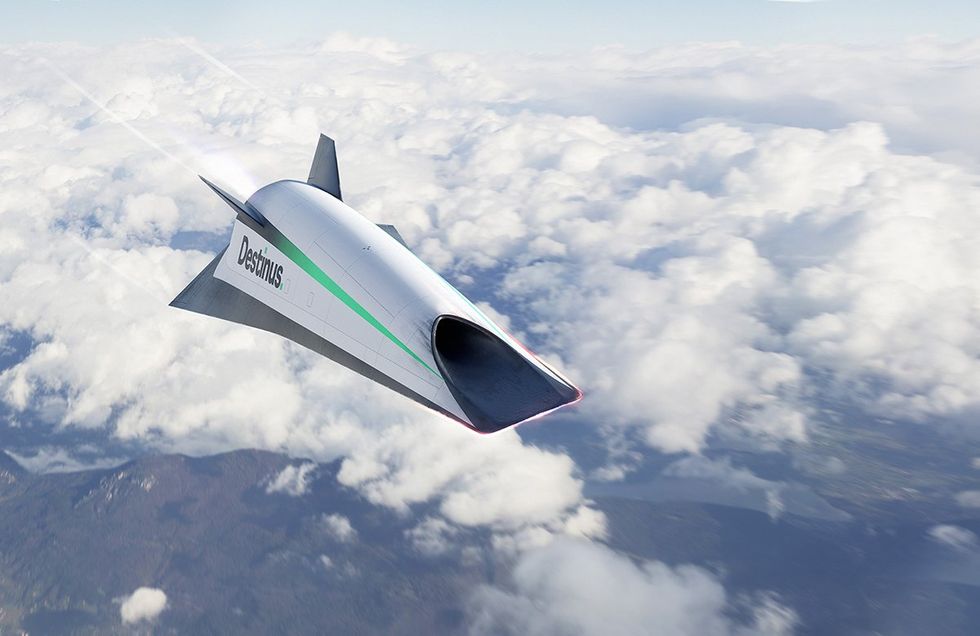By Maureen O'Hare, CNN
(CNN) – It’s now been two decades since the era of supersonic commercial flight ended with Concorde’s final touchdown in an airfield in southwest England.
In recent years, numerous pretenders to the throne – supersonic, hypersonic, hydrogen-powered, with anti-boom technology – have been whizzing round, conceptually at least, but many of these projects promising seamless super-fast travel have instead stalled, sputtered out or hit delays.
Now a European hypersonic startup is having a go, promising enticing journey times such as Frankfurt to Sydney in 4 hours 15, or Memphis to Dubai in 3 hours 30.
The Destinus concept is hydrogen-powered flight at five times the speed of sound, cutting flight duration to less than a quarter of current commercial air travel.
 COURTESY DESTINUS
COURTESY DESTINUS
Headquartered in Switzerland with a team of around 120 staff spread out in Spain, France, and Germany, Destinus was established in 2021 but has been hitting milestones fast. Its first two prototypes have made successful test flights and are about to start testing hydrogen-powered flight. Its third prototype – Destinus 3 – is set to make its inaugural flight by the end of the year.
Martina Löfqvist, the company's business development manager, caught up with CNN over video call to explain its model and why the team hopes it can be the one to finally usher in the new age of hypersonic travel.
The fuel
“There are different approaches to doing this,” says Löfqvist. While other top contenders in the field such as Boom Supersonic are “focusing more on the development of the mockups and understanding of how it works and trying to get these piloted aircraft working, we're going directly to autonomous flights.” The strategy is to “develop smaller-size drones before we scale it up to become a large pilot-driven or passenger-carrying aircraft.”
Hydrogen is the Destinus fuel of choice due to it being a clean, renewable energy source, increasingly inexpensive to produce, and capable of helping it realize its speed and long-range ambitions. Hydrogen-powered aviation is still in its infancy, with hydrogen jet engines yet to enter commercial use. Airbus is developing a hydrogen jet engine it says will begin flight testing in 2026.
“We try to go very, very ultra-long range with our vehicles,” says Löfqvist, “and that is to fly from Europe all the way to Australia at Mach 5. Using kerosene means that the vehicle would become quite heavy, while hydrogen is very light in comparison.” Hydrogen also has higher energy density than traditional jet fuel.
The long-term goal is to be fully hydrogen-powered and zero emissions, but while hydrogen production is still scaling up, its short-term plan is to power takeoff with Jet A – conventional aviation fuel – and then switch when they hit speeds of around Mach 3 "because hydrogen doesn't really become useful or better than Jet A until you get up to supersonic speeds."
The design
The Destinus prototypes are blended-body planes in the waverider shape — a hypersonic design first conceived in the 1950s but never yet reaching production — with the company’s Swiss/French origins being reflected in paintwork inspired by the Alps.
The now classic shape has “been studied for many, many, many years,” says Löfqvist. “The purpose of it is so that you can ride on top of the shock waves that are generated from the vehicle itself. It’s a pretty efficient shape where you can use less fuel to fly through it because you have less resistance with the air.”
Naturally, with every new prototype Destinus is refining and adjusting the design. Two decades from now, the team expects the crafts it’s working with to look a little different from the models it’s testing now.
The upcoming prototype, Destinus 3, will be supersonic and the hope is for it to achieve supersonic hydrogen-powered flight in 2024. “This is a pretty massive vehicle,” says Löfqvist. “It’s about the same size as the previous prototype in terms of being around 10 meters (long), but it’s 10 times heavier, and probably 20 times more complex as well, in terms of the structure and in terms of the propulsion system.”
The hoped-for timeline is that by the 2030s the company will be able to launch a smaller-scale aircraft, holding around 25 passengers, which will have some limitation in terms of range and be fully focused on business class customers.
By the 2040s, its fully scaled-up version will have multiple classes, including economy. They're hoping that by then “hydrogen prices will drop significantly, so that we can then reduce the prices of the flights, significantly as well, for these ultra-long-range flights.”
Finances
The company’s plans are quite dependent on the vagaries of the hydrogen market, which Löfqvist freely admits it’s not in control of, but experts inside and outside of the company have advised that they estimate prices to drop.
Last month Destinus acquired Dutch company OPRA, now named Destinus Energy. Says Löfqvist, “This means that we can have revenues already this year, because they already have gas turbines that are built and being sold. We’ll have now not just that hypersonic airplane aerospace side, but we’ll also have some of these energy aspects within the company as well.”
In addition to the private investment and public funding it already obtained – in April 2023 it secured grants worth 26.7 million euros ($29.4 million) from the Spanish government to expand its hydrogen propulsion capabilities – Destinus hopes this additional revenue will help it weather the challenges that have seen other supersonic and hypersonic projects fall to the wayside. Löfqvist emphasizes that the company is aiming for a “realistic” approach “now that the funding environment is a bit tougher.”
Nevada-based Aerion, which was a major contender in the race to be the first to build a supersonic passenger jet, collapsed in May 2021, declaring that “in the current financial environment, it has proven hugely challenging to close on the scheduled and necessary large new capital requirements.”
As for whether we’ll be hopping on hypersonic jets by the 2040s, breakfasting in Shanghai and hitting Sao Paulo just after lunch, there may be a few technological, environmental, and financial hurdles to overcome before then. But it won’t be for want of trying.
The-CNN-Wire
™ & © 2023 Cable News Network, Inc., a Warner Bros. Discovery Company. All rights reserved.





 COURTESY DESTINUS
COURTESY DESTINUS






































































